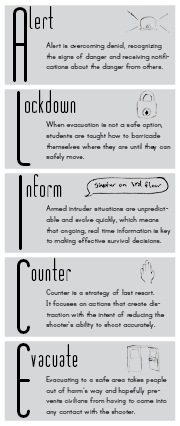Analyzing Alice
Does Garfield need to update their responses to security breaches?

In light of recent violence in America,
many facilities around the country are looking into alternate responses to security threats. One of the most popular plans is a program called ALICE, which is inherently more complicated and situational than a traditional lockdown.
Currently, Seattle Schools describes lock- downs as the ability of staff, students, and visitors to “be able to take positions in secure enclosures,” in the event of a security breach. However, as everyone at Garfield knows, the initiation of a lockdown procedure does not necessarily indicate dangerous activity inside the school.
The incident on October 3rd, for instance, in which a drive by shooting on Cherry Street prompted a lockdown followed by a shelter in place, was one of these cases. “I found out about the situation before everyone else, and because the incident happened o cam- pus, we locked down the building before we were actually told to lock down just for safe- ty purposes,” said Keenen Allen, Garfield’s school security specialist. “I took it upon myself to make sure that our students were safe.” But in spite of these precautions, and with the recent Las Vegas tragedy still fresh in our minds, many students and staff members were nervous about the possibility of being targeted by a copycat shooter.
Such events often bring up questions and concerns about our current procedure, despite there being many pros to this approach, which has been in place across the country for years. “For us it works effectively, because everyone usually abides by the rules that we have,” said Allen.
However, over the past decade, some leading officials have argued that perhaps the policy of locking doors and huddling at the backs of classrooms may accidentally create vulnerable situations. Hence, other responses have been developed.
The most common plan is an Active Shooter Response Training called “ALICE”. ALICE is an acronym for alert, lockdown, inform, counter, and evacuate. It was created by former SWAT officer Greg Crane in response to the Columbine shootings of 1999. According to the organization’s website, roughly a million people have been trained and over 4,200 school districts (31% of all schools) choose to participate.
The course is intended to teach new decision making strategies to students and staff in different scenarios involving a security breach. For instance, instead of administrators staying silent over the intercom, they’re prompted to disclose the location of the
threat. This theoretically allows people in safe areas to evacuate, while those in the im- mediate sphere of an active shooter should barricade classroom doors to discourage entry.
However, drills conducted under this system would be complex and potentially triggering for certain students. And while Allen sees the potential for ALICE, he cites parental concern over their child’s location during a situational evacuation. “It is for safety reasons, but at the same time we wouldn’t know where each student is, to stay safe. That would probably be the only hard part about that,” he said.
Furthermore, Garfield is particularly well protected. “Since we are one of the few schools with an active armed police officer who can deal with situations effectively, I’d say that what we have now at the school would work very well.” said Allen. “I can say that if we didn’t have an armed police officer in the school, then we may have some sort of issue.”
So, while finding an ideal system to handle various possible threats is a challenging and sensitive issue, it’s clear why the overall value of ALICE is being noted by a number of districts. Better to be safe than sorry.




